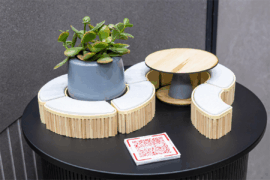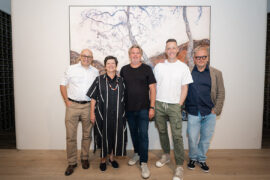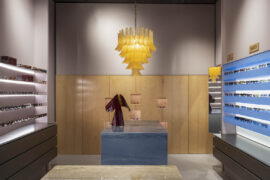Stripping office furniture back to the basics, Nendo launch an installation for Kokuyo, “shelf + desk + chair = office”.

October 15th, 2014
The shelf + desk + chair = office, at Orgatec, Cologne, respond to our changing and diverse demands for office space. Whereas “office furniture has not changed along with these demands and remains oddly standardised, Nendo’s installation returns to the fundamental principles of the office and asks what, ultimately, an office is – capturing the spirit of Kokuyo Furniture at the same time.
“For Orgatec 2014, we didn’t want Kokuyo’s exhibition to consist of nothing more than product explanations. We broke the office down into its smallest components – desks, chairs and shelving – then put it back together again, creating new relationships between the component items to explore the possibilities of future office space.
Instead of opting for the usual smooth, glossy office furniture finish, we used a varied matte finish and carried the muted black through the entire colour scheme. Combined with Kokuyo’s newest chair, the Inspine, the rough, primitive design shelving and table created an arresting contrast.”
Removing some of the shelves turns part of the shelving unit into a desk. Exploring the boundary between horizontal surfaces intended for storage, and those intended for work.

Desks and floorspace appear when the shelves are scattered right and left. An experiment in transforming shelving’s vertical levels into office three-dimensionality.
Shelves and desks mingle, and space appears inside by cutting out their overlaps. Searching for a new way of gathering together and a new spatial relationship with desks, in which we’re enclosed by our desk, rather than sit facing it.

Resting and waiting functions appear when office chairs are partially absorbed into the shelf. A consideration of the boundary between ‘on-‘ (office) and ‘off-duty’ (lobby and amenity) furniture.

Some of the shelves become a staircase. Sitting on them transforms them into benches, and when accessed from behind they’re a closed desk. A thought experiment into the relationship between dynamic and static space, and the different functions of front and back.
Photography by Hiroshi Iwasaki
Orgatec2014
orgatec.com
Kokuyo
kokuyo.com
Nendo
nendo.jp
INDESIGN is on instagram
Follow @indesignlive
A searchable and comprehensive guide for specifying leading products and their suppliers
Keep up to date with the latest and greatest from our industry BFF's!

CDK Stone’s Natasha Stengos takes us through its Alexandria Selection Centre, where stone choice becomes a sensory experience – from curated spaces, crafted details and a colour-organised selection floor.

From the spark of an idea on the page to the launch of new pieces in a showroom is a journey every aspiring industrial and furnishing designer imagines making.
Italians Massimo Grassi (president of Group Matteograssi) and award-winning architect and designer Franco Poli are partaking in a design seminar at C-ique Design Bar to discuss the technical aspects, experiments and future of their designs.
The internet never sleeps! Here's the stuff you might have missed

Eco Outdoor recently brought together developers, sustainability experts and local architects such as Adam Haddow to discuss design fundamentals, carbon targets and long-term thinking.

A calm, gallery-like boutique by Brahman Perera for One Point Seven Four brings contemporary luxury and craft to Strand Arcade.

Merging two hotel identities in one landmark development, Hotel Indigo and Holiday Inn Little Collins capture the spirit of Melbourne through Buchan’s narrative-driven design – elevated by GROHE’s signature craftsmanship.